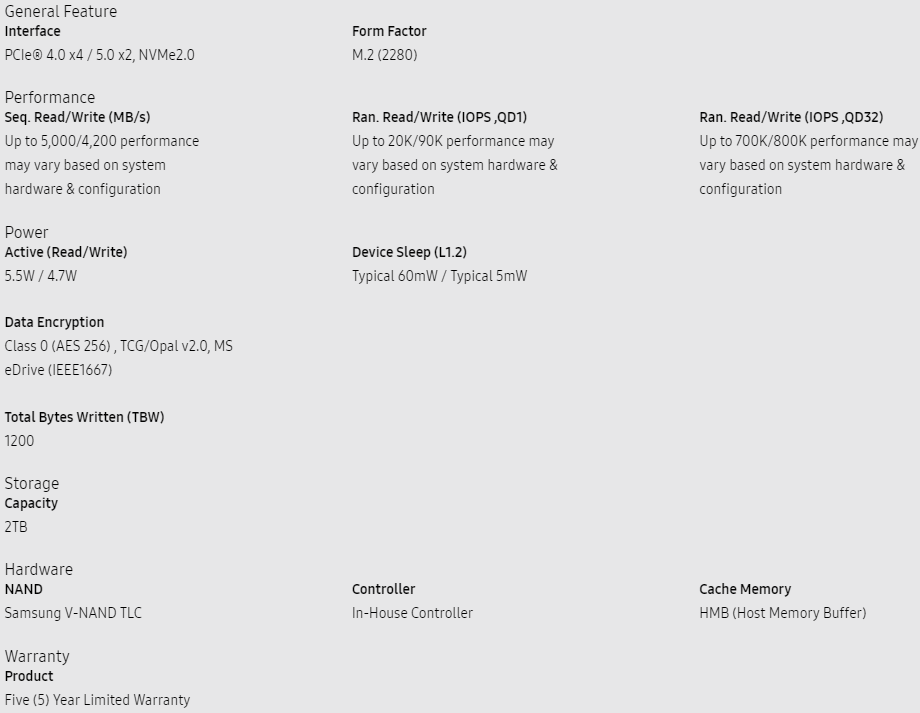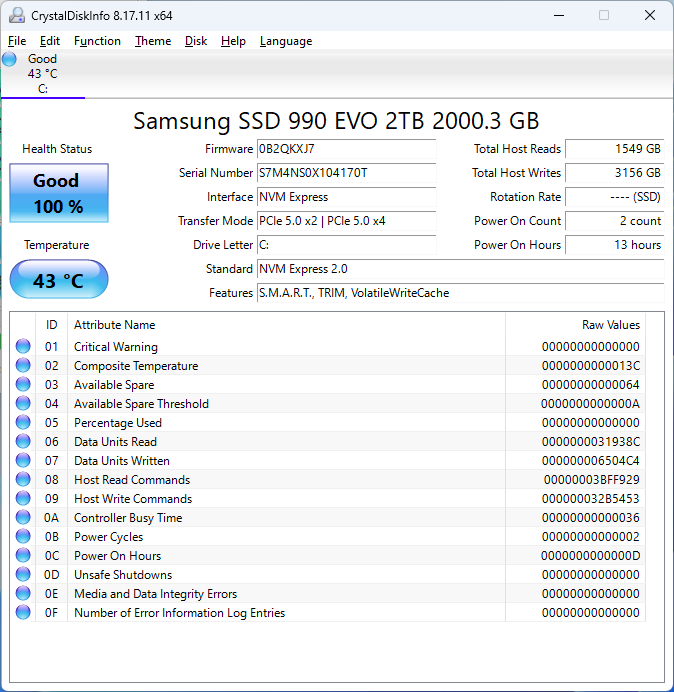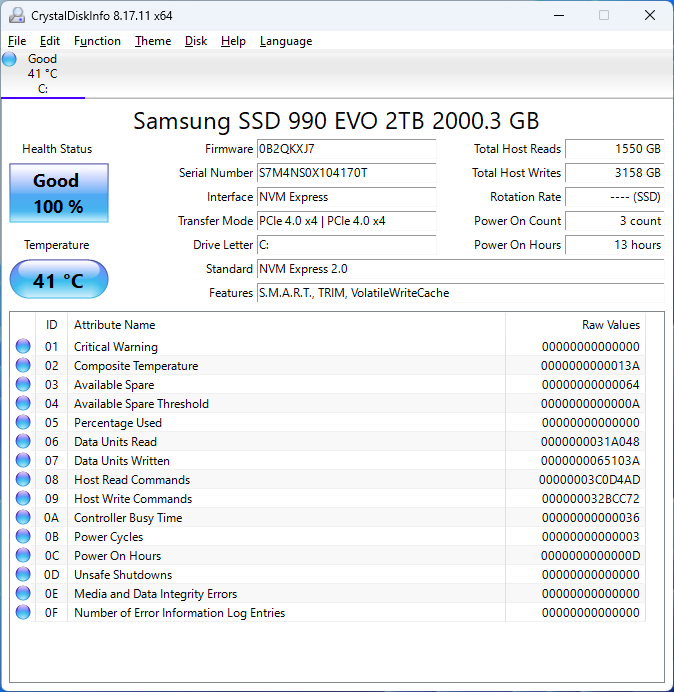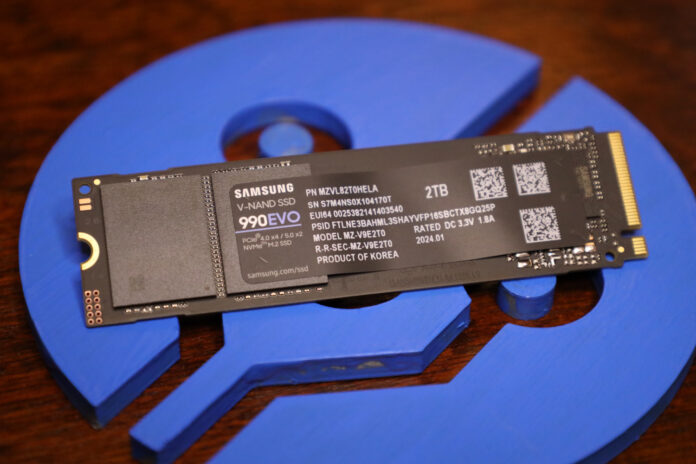Today we are looking at the Samsung 990 EVO 2TB NVMe SSD. I am very excited about this drive, as it has a trick. The 990 EVO has two modes of operation; it can either be a Gen 4 drive with x4 PCIe lanes, or it can be a Gen 5 drive with x2 PCIe lanes. The maximum PCIe bandwidth in either configuration is essentially identical, but the Gen 5 configuration uses half the lane count, which is a prospect I find appealing if it might lead to more M.2 slots on motherboards in the future. This is also the first major update to the EVO series of drives since the Gen 3 970 EVO drive, so I am eager to see this drive in action.
If you are just looking to buy the drive, you can find it here. (Amazon Affiliate)
Samsung 990 EVO 2TB SSD
The Samsung 990 EVO 2TB comes in a single-sided M.2 2280 (80mm) form factor.

Samsung very vertically integrates the 990 EVO. It is powered by an in-house Samsung controller called “Piccolo” and features Samsung’s 133-layer TLC. One change to the EVO lineup is that the 990 EVO is DRAM-less, whereas the previous 970 EVO had a DRAM cache. This is not particularly surprising to me, as Samsung has also released the Samsung 980, which also lacks a DRAM cache.

The backside of the Samsung 990 EVO 2TB has a product label and nothing else.
Samsung 990 EVO SSD Specs
The Samsung 990 EVO is available at 1TB and 2TB capacity points.

Samsung is only rating the 990 EVO at 5000MB/s sequential read and 4200MB/s sequential write. This performance point sits in the middle between top-end Gen 3 and Gen 4 performance and is a nice sweet spot for a drive targeting a modest upgrade over a Gen 3 drive. Of course, raw performance is not this drive’s primary party trick, as we will see in a moment. Endurance is on target at 600 TBW per 1TB of capacity, which gives us 1200 TBW on my 2TB drive. Lastly, the industry-standard 5-year warranty is also included.
Normally, I only post one CrystalDiskInfo screenshot to show basic information like PCIe link speed and NVMe revision. Here, you can see the 990 EVO operating in PCIe 5.0 mode on x2 lanes.

Here, you see the 990 EVO operating in PCIe 4.0 on x4 lanes. NVMe 2.0 is supported in either case. This is the big party trick for the drive. It can operate in Gen4 x4 or Gen5 x2 modes since both provide roughly the same bandwidth.

All testing, except as noted otherwise, was performed with the drive configured to run at PCIe 5.0 x2.
Test System Configuration
We are using the following configuration for this test:
- Motherboard: MSI MAG X670E Tomahawk
- CPU: AMD Ryzen 9 7900X (12C/24T)
- RAM: 2x 16GB DDR5-6000 UDIMMs
Our testing uses the Samsung 990 EVO 2TB as the boot drive for the system, installed in the M.2_1 slot on the motherboard. This slot supports up to PCIe Gen 5 x4. The drive is filled to 85% capacity with data, and then some is deleted, leaving around 60% used space on the volume.
PCIe 4.0 testing was performed with the M.2_1 slot hardcoded to Gen 4.
Next, we are going to get into our performance testing.





I predict this ability to work in x2 mode will be useful on space and pcie-lane constricted systems like laptops, mini pc’s, and embedded systems. Of course those types are systems are more likely to use some sort of OEM model installed at the factory.
I’m curious if you see the premature drive wear the same as the 990 Pro’s reported commonly. I’ve only bought Samsung SSD’s with adequate wear-leveling for some time vs other ssd’s that have all failed prematurely, but the 990’s seem plagued by high rates of wear after only a few months, whether a bug in reporting or actual, no one seems to know, but either way I’ve avoided buying ANY 990’s at this point.
Sadly not sure what other vendor *is* properly reliable if not even Samsung anymore…
What’s the performance-adjusted energy usage situation between PCIe 3, 4 and 5 at this point?
Obviously the PCIe 5 stuff is where you find the highest absolute power draws; both because that’s where the gear pushed to the edge and sold to performance enthusiasts is; and because that’s where the highest data rates are; but if you are talking joules/bit how do they stack up in terms of relative efficiency?
I don’t understand what benefit this would have against a normal gen 5 drive which can also run in gen 4 or 2x if needed?
fuzzy,
Unfortunately, essentially all M.2 drives use so little wattage that it is difficult to measure with the basic equipment I have. The 990 EVO is rated at 5.5W power draw peak, regardless of interface, with sub-1W differences between operating modes would be my assumption. Well beyond my ability to measure.
Derp,
Don’t think of it as a Gen5 drive that can run on a slower x2 link, think of it as a Gen4 drive that can run on a faster Gen5-x2 link.
@Will Taillac,
Appreciate the reply. I’m not surprised that the difference wouldn’t show up on (affordable) test equipment in a case like this. I was more curious if anyone knew if anyone who would be in the business of talking up efficiency(whether that be CPU vendors, hyperscalers discussing their design decisions, or silicon IP vendors that do PCIe PHYs like Cadence and Synopsys) has commented on whether PCIe generations are mostly a wash in joules/bit terms, just with newer ones being capable of more bits; whether there’s still a premium to be paid for speed; or whether some combination of design improvements and newer PCIe implementations getting newer fab processes means that the higher speed links are actually more efficient, per bit.
Something along the lines of when AMD was talking advanced packaging and gave picojoule/bit numbers for busses you’d have no hope of measuring in-system without downright absurd test equipment: https://www.servethehome.com/amd-talks-stacking-compute-and-dram-at-isscc-2023/ or similar talks from Intel about how EMIB and Foveros are the new hotness for tying dies together; which also gave pj/bit numbers.
For a lot of applications PCIe5 x4 SSD is overkill and one is better served by having more drives. I daresay it’s a rare PC that can actually PROCESS data at PCIe5 x4 line speed. Processing not just reading to /dev/null or NUL, mind.
I never understood the “This is not necessarily a benchmark” in Sustained Write Performance part of the test.
This is very much a benchmark, and one of the most important ones. Some SSDs are almost unusable in some applications because of terrible Sustained Write Performance
Tom,
I put that disclaimer there because I’m not particularly scientific in the way I come up with that result. The fact you see a literal screenshot of Task Manager and its reported write speed is evidence of that. This result is more of a bonus; it’s just something I record while loading the drive down with data.
There are proper ways of getting SSDs down to a steady state and then evaluating worst case performance, but I don’t do that because it takes a long time (longer than the entire rest of my benchmark suite combined), puts a ton of wear on the drives in question, and isn’t particularly relevant for consumer-class SSDs.
Do I think it’s relevant information? Absolutely, that’s why I include it. Would I bet the farm on the absolute validity and certainty of this particular result? Nope. My testing just isn’t rigorous enough for this particular number to make that claim.
I think it’s a benchmark too. You’re doing the same methodology to all the drives. It’s also useful.